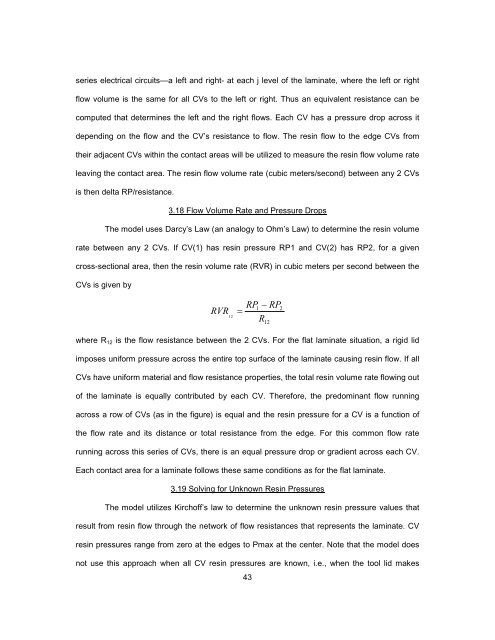TOOLED THICK COMPOSITES by ARVEN H. SAUNDERS III ...
TOOLED THICK COMPOSITES by ARVEN H. SAUNDERS III ...
TOOLED THICK COMPOSITES by ARVEN H. SAUNDERS III ...
Create successful ePaper yourself
Turn your PDF publications into a flip-book with our unique Google optimized e-Paper software.
series electrical circuits—a left and right- at each j level of the laminate, where the left or right<br />
flow volume is the same for all CVs to the left or right. Thus an equivalent resistance can be<br />
computed that determines the left and the right flows. Each CV has a pressure drop across it<br />
depending on the flow and the CV’s resistance to flow. The resin flow to the edge CVs from<br />
their adjacent CVs within the contact areas will be utilized to measure the resin flow volume rate<br />
leaving the contact area. The resin flow volume rate (cubic meters/second) between any 2 CVs<br />
is then delta RP/resistance.<br />
3.18 Flow Volume Rate and Pressure Drops<br />
The model uses Darcy’s Law (an analogy to Ohm’s Law) to determine the resin volume<br />
rate between any 2 CVs. If CV(1) has resin pressure RP1 and CV(2) has RP2, for a given<br />
cross-sectional area, then the resin volume rate (RVR) in cubic meters per second between the<br />
CVs is given <strong>by</strong><br />
RVR<br />
RP − RP2<br />
=<br />
1<br />
12 R12<br />
where R12 is the flow resistance between the 2 CVs. For the flat laminate situation, a rigid lid<br />
imposes uniform pressure across the entire top surface of the laminate causing resin flow. If all<br />
CVs have uniform material and flow resistance properties, the total resin volume rate flowing out<br />
of the laminate is equally contributed <strong>by</strong> each CV. Therefore, the predominant flow running<br />
across a row of CVs (as in the figure) is equal and the resin pressure for a CV is a function of<br />
the flow rate and its distance or total resistance from the edge. For this common flow rate<br />
running across this series of CVs, there is an equal pressure drop or gradient across each CV.<br />
Each contact area for a laminate follows these same conditions as for the flat laminate.<br />
3.19 Solving for Unknown Resin Pressures<br />
The model utilizes Kirchoff’s law to determine the unknown resin pressure values that<br />
result from resin flow through the network of flow resistances that represents the laminate. CV<br />
resin pressures range from zero at the edges to Pmax at the center. Note that the model does<br />
not use this approach when all CV resin pressures are known, i.e., when the tool lid makes<br />
43
















